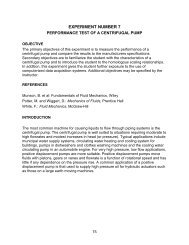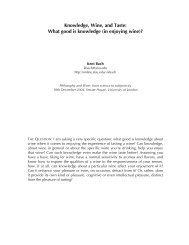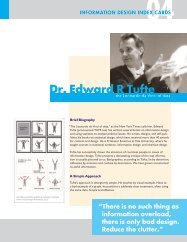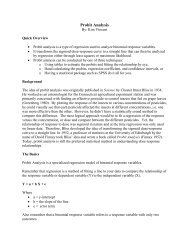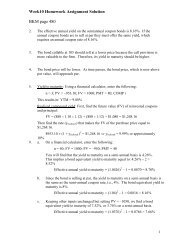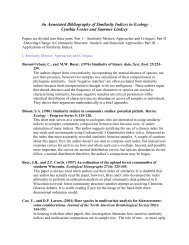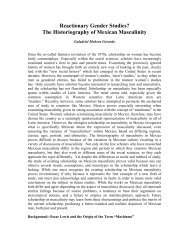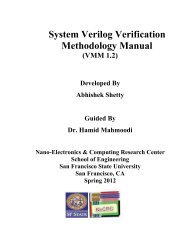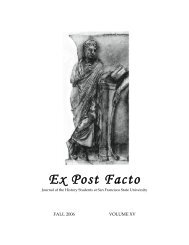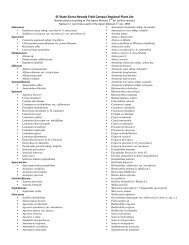Molecular Phylogeny of the Chipmunks Inferred from Mitochondrial ...
Molecular Phylogeny of the Chipmunks Inferred from Mitochondrial ...
Molecular Phylogeny of the Chipmunks Inferred from Mitochondrial ...
You also want an ePaper? Increase the reach of your titles
YUMPU automatically turns print PDFs into web optimized ePapers that Google loves.
348 PIAGGIO AND SPICER<br />
this sorting event. The maximum-likelihood branch<br />
lengths indicate a recent separation (Fig. 4). These<br />
divergences support <strong>the</strong> possibility that <strong>the</strong>se animals<br />
have recently speciated and have yet to become entirely<br />
genetically unique.<br />
N. palmeri is also part <strong>of</strong> <strong>the</strong> paraphyly; however, we<br />
have previously suggested that N. umbrinus and N.<br />
palmeri should be recognized as N. umbrinus umbrinus<br />
and N. umbrinus palmeri (Piaggio and Spicer,<br />
2000). All <strong>the</strong> rest <strong>of</strong> <strong>the</strong> taxa in <strong>the</strong> paraphyly, however,<br />
appear to be distinct species based on bacular<br />
morphology and ecological differentiation in each<br />
o<strong>the</strong>r’s presence.<br />
Sorting is evidenced by <strong>the</strong> tendency <strong>of</strong> <strong>the</strong>se species<br />
to exclude each o<strong>the</strong>r <strong>from</strong> habitats through competition,<br />
indicating that each species in <strong>the</strong> presence <strong>of</strong><br />
ano<strong>the</strong>r is specializing in a particular niche. This is one<br />
way that speciation occurs in sympatry (Schiliewen et<br />
al., 1994) or is expressed after two allopatrically speciated<br />
forms are reunited in sympatry (Rice and Hostert,<br />
1993; Losos et al., 1997, 1998; Orr and Smith,<br />
1998). Competition for habitats and specialization in<br />
separate habitats in <strong>the</strong> presence <strong>of</strong> <strong>the</strong> o<strong>the</strong>r species is<br />
common among chipmunk species (Heller, 1971; Sheppard,<br />
1971; Chappell, 1978; Sharples, 1983; Bergstrom,<br />
1992). Ecological differentiation could be a factor<br />
that led to prezygotic isolation and to morphological<br />
shifts <strong>of</strong> <strong>the</strong> reproductive morphology (i.e., bacula and<br />
baubella) resulting in postzygotic isolation and speciation.<br />
This idea is supported by White’s (1953c) evidence<br />
that each species has distinct bacular morphology.<br />
More research on <strong>the</strong> ecology and reproduction <strong>of</strong> <strong>the</strong>se<br />
species in areas <strong>of</strong> overlap and areas <strong>of</strong> isolation may<br />
test <strong>the</strong> validity <strong>of</strong> <strong>the</strong> idea that <strong>the</strong>se species represent<br />
recent or current speciation events.<br />
ACKNOWLEDGMENTS<br />
We thank <strong>the</strong> Museum <strong>of</strong> Southwestern Biology for many <strong>of</strong> <strong>the</strong><br />
tissue samples, particularly William Gannon, who spent a lot <strong>of</strong><br />
patience and time confirming identifications for us. We also thank<br />
Carla Cicero and Jim Patton <strong>of</strong> <strong>the</strong> University <strong>of</strong> California Museum<br />
<strong>of</strong> Vertebrate Zoology, Sharon Birks <strong>of</strong> <strong>the</strong> Burke Museum <strong>of</strong> Natural<br />
History, C. William Kirkpatrick <strong>of</strong> <strong>the</strong> Zaddock Thompson Natural<br />
History Collections, and Susan McLaren <strong>of</strong> <strong>the</strong> Carnegie Museum <strong>of</strong><br />
Natural History. Jack Sullivan provided an extraction <strong>of</strong> T. ruficaudus<br />
and an extremely helpful review. We also thank Derek Girman,<br />
Eric Routman, Andy Martin, and an anonymous reviewer for <strong>the</strong>ir<br />
helpful comments and suggestions. This study was partially supported<br />
by NSF Grant DEB-9629546 to G.S.S.<br />
REFERENCES<br />
Adams, D. R., and Sutton, D. A. (1968). A description <strong>of</strong> <strong>the</strong> baculum<br />
and os clitoris <strong>of</strong> Eutamias townsendii ochrogenys. J. Mammal. 49:<br />
764–769.<br />
Allen, J. A. (1891). A review <strong>of</strong> some <strong>of</strong> <strong>the</strong> North American ground<br />
squirrels <strong>of</strong> <strong>the</strong> genus Tamias. Bull. Am. Mus. Nat. Hist. III:<br />
42–65.<br />
Anderson, S., Bankier, A. T., Barrell, B. G., de Bruijn, M. H. L.,<br />
Coulson, A. R., Drouin, J., Eperon, I. C., Nierlich, D. P., Boe, B. A.,<br />
Sanger, F., Schreier, P. H., Smith, A. J. H., Staden, R., and Young,<br />
I. G. (1981). Sequence and organization <strong>of</strong> <strong>the</strong> human mitochondrial<br />
genome. Nature 290: 457–465.<br />
Bergstrom, B. J. (1992). Parapatry and encounter competition between<br />
chipmunk (Tamias) species and <strong>the</strong> hypo<strong>the</strong>sized role <strong>of</strong><br />
parasitism. Am. Midl. Nat. 128: 168–179.<br />
Black, C. C. (1963). A review <strong>of</strong> <strong>the</strong> North American Tertiary Sciuridae.<br />
Bull. Mus. Comp. Zool. Harvard 130: 113–248.<br />
Black, C. C. (1972). Holarctic evolution and dispersal <strong>of</strong> squirrels<br />
(Rodentia: Sciuridae). In “Evolutionary Biology” (T. Dobzhansky,<br />
M. Hecht, and W. Steere, Eds.), Vol. 6, pp. 305–322. Plenum, New<br />
York.<br />
Brown, J. H. (1971). Mechanisms <strong>of</strong> competitive exclusion between<br />
two species <strong>of</strong> chipmunks. Ecology 52: 305–311.<br />
Brown, J. M., Prager, E. M., Wang, A., and Wilson, A. C. (1982).<br />
<strong>Mitochondrial</strong> DNA sequences <strong>of</strong> primates: Tempo and mode <strong>of</strong><br />
evolution. J. Mol. Evol. 18: 225–239.<br />
Bryant, D. (1945). <strong>Phylogeny</strong> <strong>of</strong> Nearctic Sciuridae. Am. Midl. Nat.<br />
33: 257–390.<br />
Chappell, M. A. (1978). Behavioral factors in <strong>the</strong> altitudinal zonation<br />
<strong>of</strong> chipmunks (Eutamias). Ecology 59: 565–579.<br />
Ellerman, J. R. (1940). The families and genera <strong>of</strong> living rodents with<br />
a list <strong>of</strong> named forms (1758–1936). Br. Mus. Nat. Hist. London 1:<br />
1–689.<br />
Ellis, S. L., and Maxson, L. R. (1979). Evolution <strong>of</strong> <strong>the</strong> chipmunk<br />
genera Eutamias and Tamias. J. Mammal. 60: 331–334.<br />
Felsenstein, J. (1985). Confidence limits on phylogenies: An approach<br />
using bootstrap. Evolution 39: 783–791.<br />
Felsenstein, J. (1993). PHYLIP: <strong>Phylogeny</strong> Inference Package (ver<br />
3.5). University <strong>of</strong> Washington, Seattle.<br />
Findley, J. S. (1969). Biogeography <strong>of</strong> Southwestern boreal and<br />
desert mammals. In “Contributions in Mammalogy” (J. K. Jones,<br />
Jr., Ed.), pp. 113–128. Misc. Publ. Univ. Kansas Mus. Nat. Hist.,<br />
Vol. 51, Lawerence, KS.<br />
Giboulet, O., Chevret, P., Ramousse, R., and Catzeflis, F. (1997).<br />
DNA–DNA hybridization evidence for <strong>the</strong> Recent origin <strong>of</strong> marmots<br />
and ground squirrels (Rodentia: Sciuridae). J. Mammal.<br />
Evol. 4: 271–284.<br />
Hafner, D. J. (1984). Evolutionary relationships <strong>of</strong> <strong>the</strong> Nearctic Sciuridae.<br />
In “The Biology <strong>of</strong> Ground Dwelling Squirrels” (J. O. Murie<br />
and G. R. Michener, Eds.), pp. 3–23. Univ. <strong>of</strong> Nebraska Press,<br />
Lincoln.<br />
Hall, E. R. (1981). “The Mammals <strong>of</strong> North America,” 2nd ed., Wiley,<br />
New York.<br />
Hasegawa, M., Kishino, H., and Yano, T. (1985). Dating <strong>of</strong> <strong>the</strong> human–ape<br />
splitting by a molecular clock <strong>of</strong> mitochondrial DNA. J.<br />
Mol. Evol. 22: 160–174<br />
Heller, C. H. (1971). Altitudinal zonation <strong>of</strong> chipmunks (Eutamias):<br />
Interspecific aggression. Ecology 52: 312–319.<br />
Hillis, D. M., Mable, B. K., Larson, A., Davis, S. K., and Zimmer,<br />
E. A. (1990). Nucleic acids IV: Sequencing and cloning. In “<strong>Molecular</strong><br />
Systematics” (D. M. Hillis, C. Moritz, and B. K. Mable, Eds.),<br />
2nd ed., pp. 321–381. Sinauer, Sunderland, Massachusetts.<br />
Honeycutt, R. L., Nedbal, M. A., Ronald, M. A., and Janecek, L. L.<br />
(1995). Mammalian mitochondrial DNA evolution: A comparison<br />
<strong>of</strong> <strong>the</strong> Cytochrome b and Cytochrome c Oxidase II genes. J. Mol.<br />
Evol. 40: 260–272.<br />
Howell, A. H. (1922). Diagnoses <strong>of</strong> seven new chipmunks <strong>of</strong> <strong>the</strong> genus<br />
Eutamias, with a list <strong>of</strong> <strong>the</strong> American species. J. Mammal. 3:<br />
178–185.<br />
Howell, A. H. (1929). “Revision <strong>of</strong> <strong>the</strong> American <strong>Chipmunks</strong>,” U. S.<br />
Dep. Agric., Bureau <strong>of</strong> Biol. Survey, Washington, DC, No 52.



